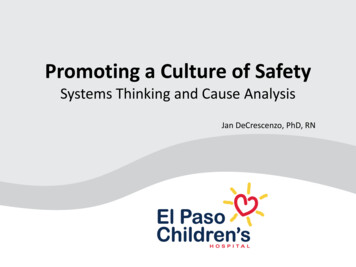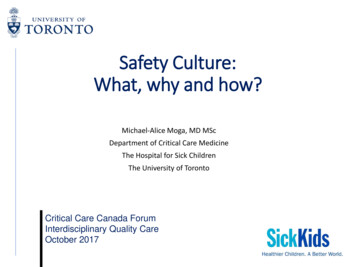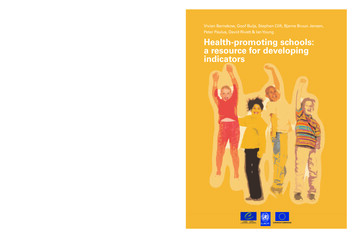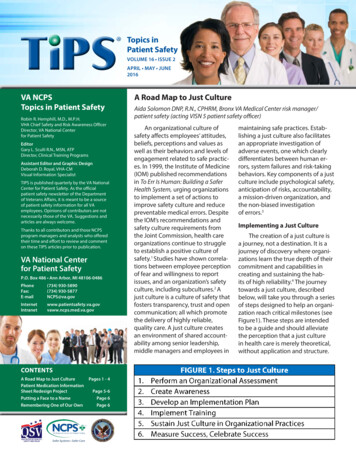
Transcription
Promoting a Culture of SafetySystems Thinking and Cause AnalysisJan DeCrescenzo, PhD, RN
Promoting a Culture of SafetyLearning Objectives The evolution of Patient Safety Identifying and reporting safety events Systems Thinking and Cause Analysis
Section 1The Advancement of Patient Safetyin the 21st Century
To Err is Human 98,000 patients die in the US each year due to problems relatedto their care (IOM, 2000) 42.7 million adverse events occur globally each year (Jha et al., 2013) 1 in 10 patients develops an adverse event such as a health-careacquired infection, fall, preventable adverse drug event, pressureulcer, etc. (Weiss et al., 2014) 12 million patients experience a diagnostic error; half of thesehave the potential to cause harm (Singh et al., 2014)
Healthcare has much room for improvementHealthCare(1 of 600)From presentation by K. Johnson, Healthcare Performance Improvement, Inc. October 16, 2014.5
Key Actions by select organizations to the IOM report The Joint Commission initiates National Patient Safety Goals National Quality Foundation lists “Never Events” Congress passes the Quality and Patient Safety Act in 2005 Healthcare organizations turn to other industries for guidancein designing High Reliability strategies
Key Requirements for Promoting a Culture of Safety1. Classify Safety Events using a Common Format2. Report Safety Events including “Near Misses”3. Adhere to a “Fair and Just Culture” approach4. Promote High Reliability leader methods and errorprevention behaviors
Classification of PATIENT SAFETY EVENTSSeriousSafetyEventsPrecursor Safety EventsNear Miss Safety Events Reaches the patient and Results in moderate to severe harm or death Reaches the patient and Results in minimal or no detectable harm Does not reach the patient Error is caught by detection or by chanceHigh Reliability ModelThe goal is to reduce the severity of safety events by increasing thereporting of all events. The more event reports we have, and the betterthe data contained within those reports, the more likely we are toidentify and correct process issues before they result in serious harm.
FAIR & JUST CULTURENot Individuals or Systems, but Individuals in Systems See human error as a symptom, not a cause Identify and correct failures, weakness, and flaws in:––––––Processes, protocolsEnvironmental design and hazardsEquipment design, availability, and effectivenessUsefulness of Policies and ProceduresProduction pressuresGoal conflicts Adhere to a Non-Punitive approach to human error
Safety at the SHARP ENDSources: Press Ganey-HPI, 2017; Flin et al., Safety at the Sharp End, 2008.Policy &Protocol“A bad system will DEFEAT agood person every time.”W. Edwards DemingMake sure systems and processes are: Part of the CULTURE. Clear, easy to understand, and easilyaccessible. Consistently followed. Reviewed and improved regularly.CULTUREWorkProcessesTechnology &EnvironmentStructureBehaviorsof Individualsand GroupsOutcomes
High Reliability Organizations Definition:Performing as intended, consistently, over time Application: Highly complex organizations with potential for catastrophicconsequences (e.g. Nuclear Power, Railroads, Commercial Airlines,Construction, NASA) Approximately 1100 healthcare systems across the U.S.
Section 2Identifying and reporting safety events
“Measuring” Patient Safety1. Determine frequency and severity of Safety Events Event types and categories Significance or Level of harm Serious Safety Event Rate Number of days since last Serious Safety Event Placement on SAFER matrix (to determine severity and frequencypriorities)2. Determine causes of these events (using a Systems Thinkingapproach) Root Cause of Serious Safety Events Common and Apparent Causes Latent factors that led to the event
What should be reported? Any departure from generally accepted practices or processes. Mistakes / human errors that involve patient care or safety concerns. Near MissesAny departure / human error that has the potential to cause harm if itreaches a patient or staff member. Any failure in the Known Complications Test1:1. Was the complication a known risk and were steps taken to mitigate it?2. Was the complication identified in a timely manner?3. Was the complication appropriately treated in a timely manner?Sources: ASHRM, 2012; Healthcare Performance Improvement, LLC. 2009.14
Safety Event Decision Algorithm*Was there an adverse event or departure fromgenerally accepted practice, performancestandard, or process?YesDid the deviation reach the patient?NoNEAR MISS orUnsafe ConditionYesDid the deviation cause moderate tosevere harm or death?YesNoPRECURSOR SAFETY EVENT(resulting in no or minimal harm)SERIOUS SAFETY EVENT*Source: Healthcare Performance Improvement, LLC. 2011.15
We NEED to KNOW what patients and familiessay about us It may seem counter-intuitive, butcapturing patient / family feedback isimportant to help us know what we needto improve.There may be many more similar issuesthat we don’t know about because theyare not shared.Knowing what makes patients and familiesunhappy help us improve the Patient /Family Experience.Use the RDE Patient Relations module forreporting Feedback shared by patients andfamilies: ComplimentsSuggestionsComplaintsGrievances
The importance of robust data analysis The following data elements are required to help usrespond to Safety Events: Significance (to determine the severity of harm)Frequency (to identify high frequency events)Tracking / trendingIdentifying process improvement needs and prioritiesReports to leadershipFollow-up with staffPresentation Title in Footer I Date17
Section 3Systems Thinking and Cause Analysis18
Why perform Cause Analysis?As physicians and leaders, we have animperative to prevent and detect problemsthat can lead to a safety event.We also have a profound obligation to correctcauses once an event has occurred.
September 2006November 2007Adult doses of heparinadministered to six babiesDennis Quaid’s newborn twins givenaccidental overdose of heparinJuly 2008March 201014 babies in Corpus Christi receivedconcentrated heparin; twins diedToddler dies in Nebraska from Heparininfusion overdose
Déjà Vu – Why Events Keep Happening1. Serious Events: Real Root Causes were not identified Corrective actions to prevent recurrence did not effectively addressthe root cause(s) and contributing factors (latent causes).2. All other Events: Not analyzed or studiedLessons learned were not aggregatedCorrective actions were never implemented or sustainedCorrective actions were not effectiveLessons learned were not shared
Human Error – A Symptom, NOT A CAUSEHuman Error – by any other name or by any otherhuman – should be the starting point of ourinvestigation, not the conclusion.Source: HPI-Press Ganey presentation with citation: Fitts, P.M., & Jones, R.E. (1947). Analysis of factors contributing to 460 piloterror experiences in operating aircraft controls. Memorandum Report TSEAA-694-12, Aero Medical Laboratory, Air MaterialCommand, Wright-Patterson Air Force Base, Dayton, Ohio.
Contemporary Influencers of System ThinkingJens Rasmussen– Defined 3 types of human task performance: Skill-based, Rule-based,and Knowledge-basedJames Reason– Expanded on Rasmussen’s Skill-Rule-Knowledge based classification ofhuman performance to define the Generic Error Modeling System– Coined the term “Sharp End” (referring to the position of personsproviding direct care or service)– Used the Swiss cheese model of causation to depict how errorspenetrate through latent weaknesses in system defenses
The Swiss Cheese ModelHarmEventMultiple Barriers (e.g., technology, processes,people) designed to stop active errors.Active Errors byindividuals result ininitiating action(s)Latent WeaknessesDETECT & CORRECTthe System WeaknessesPREVENT ERRORS
The Swiss Cheese Model15 y/o with a past history of depression and anxiety and previous suicideattempts is brought to the ED with a Chief Complaint of abdominal pain,nausea, and diarrhea. She is examined and treated for GI upset. When thenurse enters the room to give discharge instructions, she finds thepatient on the floor unconscious with an unidentified pill bottle.1.AttemptedSuicideTriage Nurse notes chief complaint,takes vital signs, and rooms thepatient. The ED is busy as always andthe nurse skips over most of thescreening questions.5.2.RN assigned to patient iscalled away to a Codebefore she completes thepatient’s assessment.3.Hospital Administration is in the process ofrevising its policy for Direct Observation ofpatients at risk for suicide and has not yetimplemented changes.4.The Attending Physicianacknowledges the patient’s anxietybut did not order a psychiatricconsultation.The Resident sees the patient and focuses onthe presenting symptoms even though she isaware of the patient’s history and observesher increasing restlessness and agitation.
ReferencesAHCA. Quality Improvement. Retrieved from https://www.ahcancal.org/quality improvement/Pages/default.aspx February 2019.CMS. Quality Assurance and Performance Improvement.Retrieved from nd-Certification/QAPI/NHQAPI.html February 2019.Flin, R., O’Connor, P., & Crichton, M. (2008). Safety at the Sharp End. Burlington, VT: Ashgate Publishing.Hoppes, M., Charney, F.J., Mitchell, J.L., Pavkovic, S.D., Sheppard, F., & Venditti, E.G. (2015). Root Cause Analysis Playbook: An EnterpriseRisk Management Approach and Implementation Guide. Chicago: American Society of Healthcare Risk Management.Hoppes, M., Mitchell, J.L., Venditti, E.G., & Bunting, R.F. (2012). Serious Safety Events: Getting to Zero , White Paper. American Society forHealthcare Risk Management.Institute for Healthcare Improvement. How to improve. Retrieved from fault.aspxFebruary 2019.Institute of Medicine. (2000). To Err is Human: Building a Safer Health System by Committee on Quality of Health in America. Boston:Institute for Healthcare Improvement.Jha, A.K., Larizgoitia, I., Audera-Lopez, C., Prasopa-Plaizier, N., Waters, H., & Bates, D.W. (2013). The global burden of unsafe medical care:Analytic modelling of observational studies. BMJ Quality and Safety, 23(7): 741-748.Press Ganey - Healthcare Performance Improvement, LLC. (2013). The HPI Cause Analysis Field Guide. Virginia Beach, VA: HPI.Hettinger, A.Z., Fairbanks, R.J., Hegde, S., Rackoff, A.S., Wreathall, J., Lewis, V.L., et al. (2013). An evidence-based toolkit for thedevelopment of effective and sustainable root cause analysis system solutions. Journal of Healthcare Risk Management 33(2): 11-20.Singh, H., Meyer, A.N.D., & Thomas, E.J. (2014). The frequency of diagnostic errors in outpatient care: Estimations from three largeobservational studies involving US adult populations. BMJ Quality and Safety, 23(9): 727-731.The Joint Commission. (1998). Sentinel Events: Evaluating Cause and Planning Improvement. Oakbrook Terrace, IL: Author.National Patient Safety Foundation. (2015). RCA2: Improving Root Cause Analyses and Actions to Prevent Harm.Retrieved from www.npsf.org.Weiss, A.J., Freeman, W.J., Heslin, K.C., & Barrett, M.L. (2014). Adverse drug events in US Hospitals, 2010 versus 2014. Statistical brief #234.Rockville, MD: Agency for Healthcare Research and Quality.Wilkerson, J. & Price, L. (2016). Using Lean Six Sigma as a Structure for an Accountable RCA Process. ECRI PSO webinar retrieved3/17/16 from www.ecri.org.
The evolution of Patient Safety Identifying and reporting safety events Systems Thinking and Cause Analysis Promoting a Culture of Safety Learning Objectives










